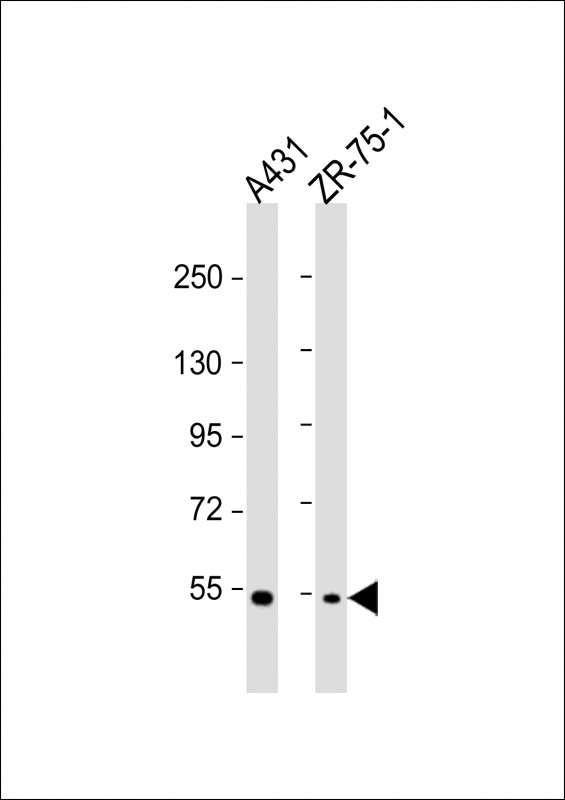MEFV Antibody(Center)
Affinity Purified Rabbit Polyclonal Antibody (Pab)
- 产品详情
- 实验流程
- 背景知识
Application
| WB, E |
|---|---|
| Primary Accession | O15553 |
| Other Accession | NP_000234.1 |
| Reactivity | Human |
| Host | Rabbit |
| Clonality | Polyclonal |
| Isotype | Rabbit IgG |
| Calculated MW | 86444 Da |
| Antigen Region | 418-445 aa |
| Gene ID | 4210 |
|---|---|
| Other Names | Pyrin, Marenostrin, MEFV, MEF |
| Target/Specificity | This MEFV antibody is generated from rabbits immunized with a KLH conjugated synthetic peptide between 418-445 amino acids from the Central region of human MEFV. |
| Dilution | WB~~1:1000 E~~Use at an assay dependent concentration. |
| Format | Purified polyclonal antibody supplied in PBS with 0.09% (W/V) sodium azide. This antibody is purified through a protein A column, followed by peptide affinity purification. |
| Storage | Maintain refrigerated at 2-8°C for up to 2 weeks. For long term storage store at -20°C in small aliquots to prevent freeze-thaw cycles. |
| Precautions | MEFV Antibody(Center) is for research use only and not for use in diagnostic or therapeutic procedures. |
| Name | MEFV {ECO:0000303|PubMed:11115844, ECO:0000312|HGNC:HGNC:6998} |
|---|---|
| Function | Involved in the regulation of innate immunity and the inflammatory response in response to IFNG/IFN-gamma (PubMed:10807793, PubMed:11468188, PubMed:16037825, PubMed:16785446, PubMed:17431422, PubMed:17964261, PubMed:18577712, PubMed:19109554, PubMed:19584923, PubMed:26347139, PubMed:27030597, PubMed:28835462). Organizes autophagic machinery by serving as a platform for the assembly of ULK1, Beclin 1/BECN1, ATG16L1, and ATG8 family members and recognizes specific autophagy targets, thus coordinating target recognition with assembly of the autophagic apparatus and initiation of autophagy (PubMed:16785446, PubMed:17431422, PubMed:26347139). Acts as an autophagy receptor for the degradation of several inflammasome components, including CASP1, NLRP1 and NLRP3, hence preventing excessive IL1B- and IL18-mediated inflammation (PubMed:16785446, PubMed:17431422, PubMed:26347139). However, it can also have a positive effect in the inflammatory pathway, acting as an innate immune sensor that triggers PYCARD/ASC specks formation, caspase-1 activation, and IL1B and IL18 production (PubMed:16037825, PubMed:27030597, PubMed:28835462). Together with AIM2, also acts as a mediator of pyroptosis, necroptosis and apoptosis (PANoptosis), an integral part of host defense against pathogens, in response to bacterial infection (By similarity). It is required for PSTPIP1-induced PYCARD/ASC oligomerization and inflammasome formation (PubMed:10807793, PubMed:11468188, PubMed:17964261, PubMed:18577712, PubMed:19109554, PubMed:19584923). Recruits PSTPIP1 to inflammasomes, and is required for PSTPIP1 oligomerization (PubMed:10807793, PubMed:11468188, PubMed:17964261, PubMed:18577712, PubMed:19109554, PubMed:19584923). |
| Cellular Location | [Isoform 1]: Cytoplasm, cytoskeleton. Cell projection, ruffle. Cell projection, lamellipodium. Nucleus. Cytoplasm. Cytoplasmic vesicle, autophagosome. Note=Associated with microtubules and with the filamentous actin of perinuclear filaments and peripheral lamellar ruffles (PubMed:11468188). In pre- apoptotic cells, colocalizes with PYCARD/ASC in large specks (inflammasomes) (PubMed:11468188). In migrating monocytes, strongly polarized at the leading edge of the cell where it colocalizes with polymerizing actin and PYCARD/ASC (PubMed:11468188) |
| Tissue Location | Expressed in peripheral blood leukocytes, particularly in mature granulocytes and to a lesser extent in monocytes but not in lymphocytes. Detected in spleen, lung and muscle, probably as a result of leukocyte infiltration in these tissues. Not expressed in thymus, prostate, testis, ovary, small intestine, colon, heart, brain, placenta, liver, kidney, pancreas. Expression detected in several myeloid leukemic, colon cancer, and prostate cancer cell lines |
For Research Use Only. Not For Use In Diagnostic Procedures.
Provided below are standard protocols that you may find useful for product applications.
BACKGROUND
This gene encodes a protein, also known as pyrin or marenostrin, that is an important modulator of innate immunity. Mutations in this gene are associated with Mediterranean fever, a hereditary periodic fever syndrome.
REFERENCES
Cosan, F., et al. Arthritis Rheum. 62(11):3232-3236(2010)
Shimada, M., et al. Hum. Genet. 128(4):433-441(2010)
Bailey, S.D., et al. Diabetes Care 33(10):2250-2253(2010)
He, X., et al. Pediatr. Nephrol. 25(10):2077-2082(2010)
Simsek, I., et al. Clin. Rheumatol. (2010) In press :
终于等到您。ABCEPTA(百远生物)抗体产品。
点击下方“我要评价 ”按钮提交您的反馈信息,您的反馈和评价是我们最宝贵的财富之一,
我们将在1-3个工作日内处理您的反馈信息。
如有疑问,联系:0512-88856768 tech-china@abcepta.com.























 癌症的基本特征包括细胞增殖、血管生成、迁移、凋亡逃避机制和细胞永生等。找到癌症发生过程中这些通路的关键标记物和对应的抗体用于检测至关重要。
癌症的基本特征包括细胞增殖、血管生成、迁移、凋亡逃避机制和细胞永生等。找到癌症发生过程中这些通路的关键标记物和对应的抗体用于检测至关重要。 为您推荐一个泛素化位点预测神器——泛素化分析工具,可以为您的蛋白的泛素化位点作出预测和评分。
为您推荐一个泛素化位点预测神器——泛素化分析工具,可以为您的蛋白的泛素化位点作出预测和评分。 细胞自噬受体图形绘图工具为你的蛋白的细胞受体结合位点作出预测和评分,识别结合到自噬通路中的蛋白是非常重要的,便于让我们理解自噬在正常生理、病理过程中的作用,如发育、细胞分化、神经退化性疾病、压力条件下、感染和癌症。
细胞自噬受体图形绘图工具为你的蛋白的细胞受体结合位点作出预测和评分,识别结合到自噬通路中的蛋白是非常重要的,便于让我们理解自噬在正常生理、病理过程中的作用,如发育、细胞分化、神经退化性疾病、压力条件下、感染和癌症。







